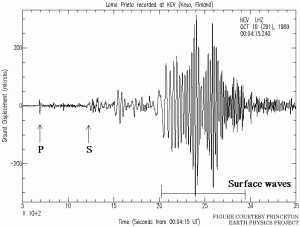17 December 2010
Warning: Shaking, rattling, and rolling about to occur
Posted by mohi
On Wednesday, I encountered a curious cab driver. He wanted to know what was happening in the Moscone center, as he’d noticed herds of people crossing the road. “It’s a meeting of the American Geophysical Union,” I said.
“Huh?”
“Really smart people who study volcanoes and planets and earthquakes and stuff.”
“Earthquakes? Ah. Tell me about earthquakes. In San Francisco. When will it happen?” he asked.
I apologized profusely, saying I had no idea, was a geneticist and didn’t know much about earthquakes except they are noisy, terrifying and often strike without warning.
If only I had seen that cabbie a day later! I learned on Thursday that scientists in Japan have developed an earthquake warning system–and though it doesn’t predict earthquakes, it does provide several seconds of warning time. The warning interval varies, depending on the distance to the quake’s epicenter.
That early warning system, Kinkyu Jishin Sokuhou in Japanese, was the topic of a presentation by Kyoto University’s Jim Mori during Thursday afternoon’s session NH43B: Transmitting Hazard Science to End Users: What Works, What Doesn’t, and What’s Needed? II.

A successful warning must be issued at the arrival time of the P-wave, and must reach the public before the S-wave arrives,
The system, operated by the Japan Meterological Agency, was born on fall 2007 and utilizes the myriad of seismometers sprinkled throughout Japan’s islands. It works by taking advantage of two different flavors of seismic waves comprising earthquakes: p-waves and s-waves. P-waves are less violent and travel quickly through the earth’s crust, meaning they reach seismometers first. S-waves are responsible for the shaking and are slower, meaning there’s a lag between the first p-wave and the subsequent onset of shaking. So, when sensors detect p-waves indicating an energetic earthquake, they automatically broadcast a warning over 124 Japanese TV stations, 76 radio stations, and more than 52 million cell phones. Mori said private companies are signing up to help distribute the warnings, which include predicted intensities, magnitudes, and affected locations.
“This all has to happen very quickly–on the order of seconds, because seismic waves travel very fast,” Mori said.
Mori said the system works best for deep, offshore earthquakes, where the warning time can be the longest. “You can get maybe 20 or 30 seconds of warning,” he said. For quakes that are closer, the warning time is much less.
In the past three years, 21 warnings have been issued. Elapsed times between the detection of the first p-wave and the transmission of the warning ranged between 4 and 26 seconds, with times to s-wave arrival varying between 5 and 30 seconds.
“What do you do in those first few seconds after a warning arrives?” Mori asked. Good question. What would you do? I’d probably freeze, and then dive for cover.
Mori said the Japanese population is particularly well-suited for this kind of rapid early-warning system because they’re a “high tech society that is accustomed to fast information.”
I wonder what my friendly cab driver would say about this!
–Nadia Drake is a science communication graduate student at U.C. Santa Cruz










 GeoSpace is a blog on Earth and space science, managed by AGU’s Public Information staff. The blog features posts by AGU writers and guest contributors on all sorts of relevant science topics, but with a focus on new research and geo and space sciences-related stories that are currently in the news.
GeoSpace is a blog on Earth and space science, managed by AGU’s Public Information staff. The blog features posts by AGU writers and guest contributors on all sorts of relevant science topics, but with a focus on new research and geo and space sciences-related stories that are currently in the news.